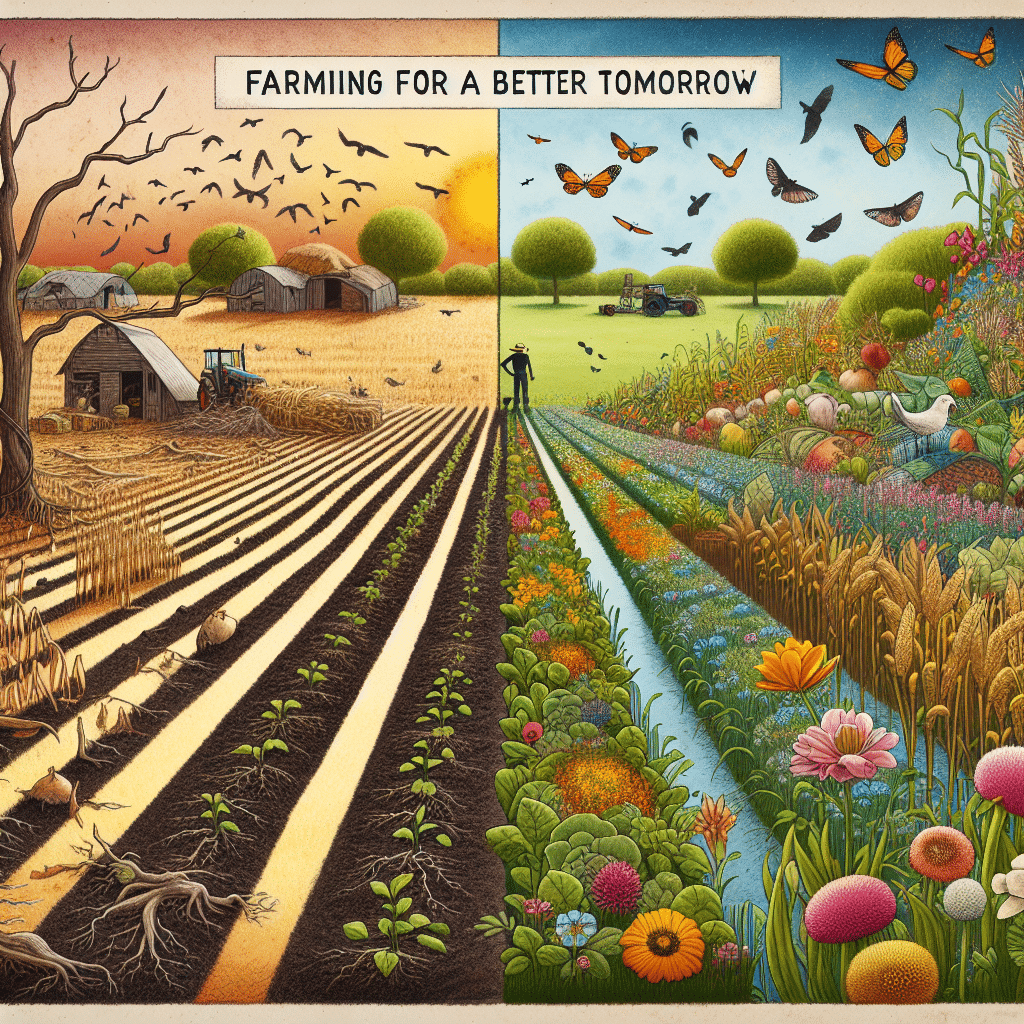Regenerative Agriculture: Farming for a Better Tomorrow
-
Table of Contents
- Regenerative Agriculture: Pioneering Sustainable Farming Practices
- Understanding Regenerative Agriculture
- The Principles of Regenerative Agriculture
- Benefits of Regenerative Agriculture
- Real-World Examples of Regenerative Agriculture
- Challenges and Considerations
- Conclusion: Embracing the Future of Farming
- ETprotein: Supporting Sustainable Agriculture with High-Quality Protein Products
Regenerative Agriculture: Pioneering Sustainable Farming Practices

As the world grapples with the challenges of climate change, food security, and environmental degradation, a transformative approach to agriculture is emerging as a beacon of hope. Regenerative agriculture is not just a method of farming; it’s a philosophy that seeks to rehabilitate and enhance the entire ecosystem of the farm by placing a heavy emphasis on soil health and the biodiversity of an agricultural system. This approach has the potential to create a more resilient food system and a better tomorrow.
Understanding Regenerative Agriculture
Regenerative agriculture is a conservation and rehabilitation approach to food and farming systems. It focuses on topsoil regeneration, increasing biodiversity, improving the water cycle, enhancing ecosystem services, supporting biosequestration, increasing resilience to climate change, and strengthening the health and vitality of farm soil.
The Principles of Regenerative Agriculture
At the heart of regenerative agriculture are several key principles that guide farmers and land managers in their practices:
- Enhancing Soil Health: This involves practices such as no-till farming, cover cropping, and crop rotation to increase soil organic matter and biodiversity, leading to improved structure, water retention, and nutrient cycling.
- Water Management: Efficient use of water through practices like swales, keyline design, and rainwater harvesting helps to restore natural water cycles and reduce reliance on irrigation.
- Biodiversity: Encouraging a variety of plant and animal species on the farm enhances resilience and productivity.
- Integrating Livestock: Managed grazing techniques mimic natural herd movements, which can improve soil health and plant growth.
- Reducing Chemical Inputs: Minimizing the use of synthetic fertilizers, pesticides, and herbicides reduces environmental impact and promotes natural ecosystem functions.
Benefits of Regenerative Agriculture
Regenerative agriculture offers a multitude of benefits that extend far beyond the farm:
- Carbon Sequestration: Healthy soils have the ability to sequester carbon from the atmosphere, mitigating the effects of climate change.
- Improved Soil Health: Regenerative practices lead to soils rich in organic matter and microbial life, which are more fertile and less prone to erosion.
- Water Conservation: By improving soil structure and water retention, regenerative farms can become more drought-resistant and reduce water usage.
- Enhanced Biodiversity: Diverse ecosystems are more productive and resilient to pests and diseases.
- Economic Resilience: Diversified regenerative systems can provide multiple streams of income and reduce risk for farmers.
Real-World Examples of Regenerative Agriculture
Across the globe, innovative farmers and organizations are putting regenerative agriculture into practice with remarkable results:
- Gabe Brown’s Ranch in North Dakota: By implementing no-till practices, diverse cover crops, and rotational grazing, Brown has transformed his 5,000-acre ranch into a model of regenerative agriculture, improving soil health and farm profitability.
- The Loess Plateau Project in China: This large-scale land restoration project has rehabilitated 35,000 square kilometers of degraded land through terracing, tree planting, and sustainable farming practices, dramatically improving local livelihoods and ecosystems.
- Rodale Institute’s Farming Systems Trial: The longest-running side-by-side comparison of organic and conventional agriculture in North America has shown that organic regenerative systems can outperform conventional in terms of yield, soil health, and economic viability, especially during drought conditions.
Challenges and Considerations
While regenerative agriculture holds great promise, there are challenges to its widespread adoption:
- Economic Barriers: Transitioning to regenerative practices can require significant upfront investment and a period of reduced yields.
- Knowledge and Training: Farmers need access to education and support to learn new techniques and understand complex ecological processes.
- Policy and Incentives: Agricultural policies often favor conventional farming methods, and there is a need for incentives that support regenerative practices.
Conclusion: Embracing the Future of Farming
Regenerative agriculture represents a paradigm shift in our approach to food production. By working with nature rather than against it, we can create a farming system that is not only sustainable but also regenerative. This approach has the potential to restore our soils, enhance biodiversity, improve water cycles, and help combat climate change. As more farmers and consumers become aware of the benefits of regenerative agriculture, we can expect to see a significant transformation in the way our food is grown, leading to a healthier planet and a better tomorrow.
ETprotein: Supporting Sustainable Agriculture with High-Quality Protein Products
In line with the principles of sustainable and regenerative agriculture, ETprotein is committed to providing high-quality, organic protein products that support the health of both people and the planet. Their range of plant-based proteins, including rice, pea, and various seed proteins, are produced with a focus on environmental responsibility and nutritional value.
ETprotein’s offerings are ideal for those looking to incorporate sustainable, non-GMO, and allergen-free ingredients into their diets. By choosing ETprotein, consumers and manufacturers can contribute to a more sustainable food system that aligns with the values of regenerative agriculture.
For more information on how ETprotein’s products can support your health and sustainability goals, please contact sales(at)ETprotein.com.
About ETprotein:
ETprotein, a reputable protein and L-(+)-Ergothioneine (EGT) Chinese factory manufacturer and supplier, is renowned for producing, stocking, exporting, and delivering the highest quality organic bulk vegan proteins and L-(+)-Ergothioneine. They include Organic rice protein, clear rice protein, pea protein, clear pea protein, watermelon seed protein, pumpkin seed protein, sunflower seed protein, mung bean protein, peanut protein, and L-(+)-Ergothioneine EGT Pharmaceutical grade, L-(+)-Ergothioneine EGT food grade, L-(+)-Ergothioneine EGT cosmetic grade, L-(+)-Ergothioneine EGT reference grade and L-(+)-Ergothioneine EGT standard. Their offerings, characterized by a neutral taste, non-GMO, allergen-free attributes, with L-(+)-Ergothioneine purity over 98%, 99%, cater to a diverse range of industries. They serve nutraceutical, pharmaceutical, cosmeceutical, veterinary, as well as food and beverage finished product distributors, traders, and manufacturers across Europe, USA, Canada, Australia, Thailand, Japan, Korea, Brazil, and Chile, among others.
ETprotein specialization includes exporting and delivering tailor-made protein powder and finished nutritional supplements. Their extensive product range covers sectors like Food and Beverage, Sports Nutrition, Weight Management, Dietary Supplements, Health and Wellness Products, and Infant Formula, ensuring comprehensive solutions to meet all your protein needs.
As a trusted company by leading global food and beverage brands and Fortune 500 companies, ETprotein reinforces China’s reputation in the global arena. For more information or to sample their products, please contact them and email sales(at)ETprotein.com today.














